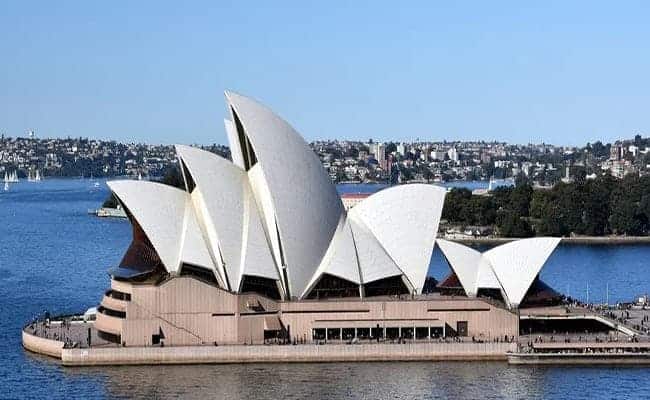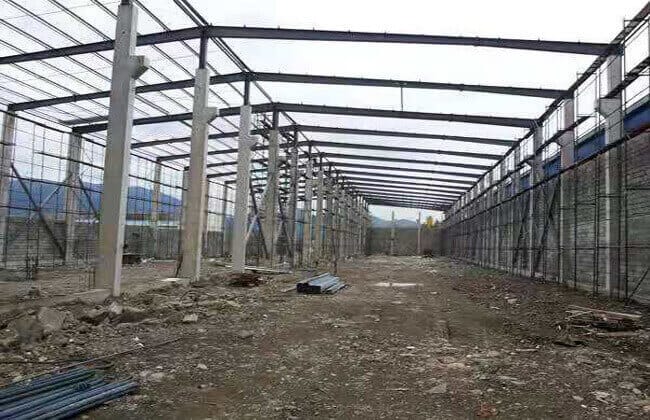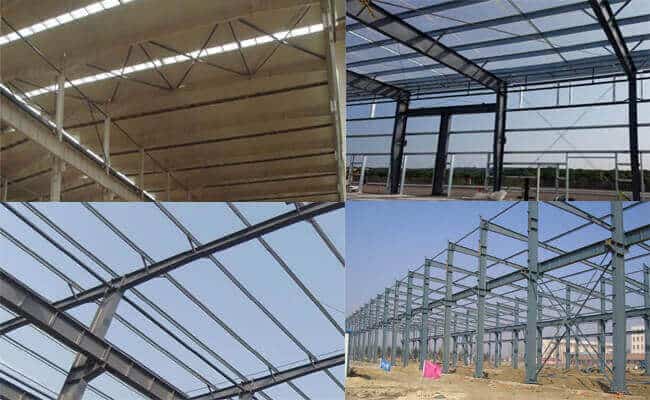Home » Steel Building » specification » The Type of Steel Building Structures
The types of steel building structures are the portal rigid steel frame, the frame structure, the truss structure, and the grid structure. Understanding the advantages and disadvantages of different structural systems is essential to design your project correctly. The forms of stress are also different.
Table of Contents
Features and applications of the standard type of steel building structures:
1. Portal Frame Steel Building Structures
2. Steel Building Frame Structures
3. Steel Truss Structure
4. Steel Grid Structure
5. Cold-formed thin-walled steel building structures
Application of cold-formed thin-walled steel structure.
The composition of the portal frame steel workshop system:
Common nodes of portal frame
The composition of the steel frame structure
Common nodes of steel frame structure
The composition of the steel truss structure
The composition of the Steel grid structure
Miracles of Steel – These “world famous buildings” are all steel structure buildings
Eiffel Tower
Millennium Dome
Golden Gate Bridge
Gateway Arch
Sydney Opera House
Tokyo Tower
World Trade Center
Petronas Twin Towers
Sears Tower
Bird’s Nest
Steel Building Structures VS Reinforced Concrete
Economy
Construction Schedule
Carrying capacity
Basic cost
Shock resistance
Ample space and floor plan
Mobility
Features and applications of the standard type of steel building structures:
2.Steel building frame structures are used to construct high-rise and super high-rise buildings, multi-story buildings, and commercial office buildings with the flexibility of their structure. A steel building frame can be adjusted to suit your needs.
3.The advantage of Steel Truss Structure is that small cross-section rods can be used to form larger cross-section components, which are often used in industrial and civil buildings such as roofs, bridges, TV towers, mast towers, marine oil production platforms, tower corridors, etc., with large spans or heights In the building.
4.The Steel Grid Structure is a high-order, statically indeterminate space structure composed of many rods according to specific rules. The space is small in force, light in weight, rigid, and has good seismic resistance. It can be used as a gymnasium, exhibition hall, rain roof, and canopies and hangars.
1. Portal Frame Steel Building Structures
The rigid portal frame is a structure with rigidly connected beams and columns. It has the characteristics of a simple structure, lightweight, reasonable stress, and simple construction. Therefore, it is widely used in industrial, commercial, agricultural, and Institutional Buildings.

portal steel frame
2. Steel Building Frame Structures

Steel Structure Frame Building
3. Steel Truss Structure
The advantage of the steel truss is that it is used to form more significant members with smaller cross-sections. It is often used in roofs, bridges, TV towers, mast towers, marine oil platforms, and tower corridors of industrial and civil buildings.

steel truss structure
4. Steel Grid Structure
Space Truss Steel Structure
5. Cold-formed thin-walled steel building structures
In industrial, civil, and agricultural buildings, thin-walled steel building structures can make various structures and components, such as roof trusses, rigid frames, grids, purlins, wall beams, and columns.

Cold-formed thin-walled steel structures
Application of cold-formed thin-walled steel structure.
Cold-formed thin-walled steel is used as secondary components and enclosure structures such as roof purlins, wall frame beams and columns, keels, doors and windows, roof panels, wall panels, floor slabs, etc.
Cold-formed steel-concrete composite structures that use cold-formed steel and reinforced concrete to form composite beams, plates, and columns have also become a new research direction in engineering.
The composition of the portal frame steel workshop system:

Steel Structure Factory Building
Common nodes of portal frame

portal frame nodes
The composition of the steel frame structure
The steel frame structure system is generally divided into frame structure, frame bracing structure, frame shear wall structure, and frame tube structure.
Frame structure: The frame comprises columns and beams bearing vertical and lateral forces. Steel columns generally use H-shaped steel, box-shaped steel columns, or steel tube concrete columns.
Frame bracing structure: The frame comprises columns and beams, and bracings are provided between the columns to resist lateral forces.
Frame shear wall structure: similar to the frame bracing structure, except that the bracing is replaced with a shear wall to resist lateral forces.
The shear wall is generally a concrete slab, steel plate, or a steel-concrete composite structure with better lateral stiffness than bracing. It is more flexible in layout and suitable for higher building structures.
Frame tube structure: The structure generally comprises a reinforced concrete core tube and an outer ring steel frame.
The system form uses pure steel frames in the horizontal direction and arranges an appropriate number of vertical inter-column bracing in the longitudinal direction to strengthen the longitudinal rigidity, reduce the amount of steel used in the frame, and form a larger space.

steel building structures
Common nodes of steel frame structure

steel frame structure node
The composition of the steel truss structure

steel truss structure
The composition of the Steel grid structure

steel grid structure
Miracles of Steel – These “world famous buildings” are all steel structure buildings
Eiffel Tower
The Eiffel Tower was built in 1889. This hollow structure iron tower is located on the Champ de Mars in Paris, France. It is 300 meters high, with an antenna height of 24 meters and 324 meters.
The tower is a hollow steel frame structure with three-level platforms at an altitude of 57 meters, 115 meters, and 274 meters for tours. The fourth-level platform houses a weather station 300 meters above sea level.

There is an antenna on the top, which is the Paris Television Center. There are elevators and 710 steps from the ground to the top of the tower. It is understood that the tower used more than 1,500 giant prefabricated beams, 1.5 million rivets, and 12,000 steel castings, with a total weight of 7,000 tons. It took 250 workers 17 months to build it.
Millennium Dome
The Millennium Dome, located on the Greenwich Peninsula on the banks of the Thames River in east London, is a landmark building built by the British government to welcome the 21st century.
The diameter of the bend is 320m, and the circumference is more than 1000m. Twelve masts penetrate the roof and reach a height of 100m. The top adopts a spherical tension membrane structure.

Millennium Dome
The membrane surface is supported on 72 radial steel cables with a cross-section of 2×φ32. The mast supports these steel cables through cable-stayed slings and lanyards spaced 25m apart. The slings and lanyards simultaneously stabilize the mast.
It is understood that the Millennium Dome is a large-scale comprehensive exhibition building covering an area of 73 hectares with a total cost of US$1.25 billion. It includes a series of display and performance venues, shopping malls, restaurants, bars, etc.
Golden Gate Bridge
The Golden Gate Bridge spans north and south, connecting the city of San Francisco and Marin County. The bridge, which took more than four years to build, is one of the most beautiful structures in the world. It is no longer the longest suspension bridge in the world but the most famous.
The massive tower of the Golden Gate Bridge is 227 meters high. Each steel cable weighs 6,412 metric tons and is made of 27,000 steel wires. Construction began in January 1933 and was first completed and opened to traffic in May 1937.

The steel tower stands on the north and south sides of the bridge, with a height of 342 meters, of which the part above the water is 227 meters, equivalent to a 70-story building. Two steel cables connect the top of the tower, each with a diameter of 92.7 centimeters and a weight of 24,500 tons.
The midpoint of the steel cables droops, almost close to the bridge body. The steel cables and the bridge body are connected with thin steel ropes. Data show that the bridge span between the steel towers reaches 1,280 meters, making it one of the rare single-hole long-span suspension bridges built in the world.
Gateway Arch
The Gateway Arch in St. Louis, Missouri, is the tallest freestanding monument in the United States. This gleaming arc-shaped building made of steel rises from the ground, nearly 200 meters high, and its span is also about 200 meters, the same as its height.

According to records, Finnish-American and famous architectural designer Ilo Salinen designed the Gateway Arch in a national design competition in the late 1940s. However, the project did not start until February 1963 and was completed in October 1965. Later, a transportation system was added to the arch, allowing people to climb to a viewing platform at the top of the hook and take in the views. The Gateway Arch, located on the banks of the Mississippi River, is known as the gateway to the West.
Sydney Opera House
Its appearance is three groups of giant shells standing on the base of a cast-in-place reinforced concrete structure that is 186 meters long from north to south and 97 meters wide at its widest point from east to West.

Tokyo Tower

There is a two-story observation deck at a height of 100 meters; at an altitude of 250 meters, there is also a unique observation deck. Large floor-to-ceiling glass windows are on all sides of the observatory, and the windows tilt outward. Standing on the observation deck, you can overlook the city of Tokyo and have a panoramic view of the entire city.
World Trade Center
The World Trade Center comprises two side-by-side tower skyscrapers, four 7-story office buildings, and a 22-story hotel. It was built from 1962 to 1976. The owner is the Port Authority of New York and New Jersey. The World Trade Center was once the tallest twin towers in the world, a landmark building in New York City, and one of the tallest buildings in the world.

World Trade Center
Petronas Twin Towers
The Petronas Twin Towers in Kuala Lumpur are 452 meters high and have 88 floors above ground. The building, designed by American architect Cesar Pelli, uses many materials, such as stainless steel and glass, on its surface. The Petronas Twin Towers and the neighboring Kuala Lumpur Tower are well-known landmarks and symbols of Kuala Lumpur.

Petronas Twin Towers
Sears Tower
In 2009, London-based insurance brokerage Willis Group agreed to lease a large proportion of the building as an office building and also acquired the building as part of the contract. Naming rights. At 10:00 on July 16, 2009, the official name of the building was officially changed to Willis Group Building.

Sears Tower
The building adopts a tube structural system composed of steel frames. The entire building is treated as a cantilevered beam space structure. The further away from the ground, the smaller the shear force. The vibrations caused by wind pressure at the top of the building are also significantly reduced. This dramatically enhances the building’s stiffness and ability to resist lateral forces.
Bird’s Nest
The Bird’s Nest is the main stadium for the 2008 Beijing Olympic Games. The giant stadium design, completed by the 2001 Pritzker Prize winners Herzog and de Meuron in collaboration with Chinese architect Li Xinggang, is shaped like a “nest” that breeds life. Hope for the future. The designers did not do anything superfluous to the National Stadium but left the structure exposed, thus naturally forming the appearance of the building. In July 2007, the British “Times” ranked the ten most prominent and most important construction projects under construction in the world, and the “Bird’s Nest” ranked first at that time. The latest issue of the American “Time” magazine, published on December 24 of the same year, selected the top ten architectural wonders in the world in 2007, and the Bird’s Nest is worthy of being on the list.

Bird's Nest
Steel Building Structures VS Reinforced Concrete
Economy
Traditional reinforced concrete buildings have a high civil construction cost and long construction periods. The cost is susceptible to unpredictable factors, such as natural disasters, construction in winter and rainy seasons, and rising material prices.
Construction Schedule
The construction speed of traditional reinforced concrete structures is slow, and the construction period can reach 8-10 months or longer.
Carrying capacity
In traditional reinforced concrete buildings, the structure’s weight is often equal to its designed load-bearing capacity, and the prefabricated components are heavy, requiring high-lifting equipment.
Basic cost
Traditional reinforced concrete buildings have complicated foundation treatment due to their complex self-weight. Over half of the total structure cost will be used for the foundation in poor soil quality.
Shock resistance
Traditional reinforced concrete buildings are based on the material properties of concrete. Compared with light steel structures, reinforced concrete buildings are more prone to brittle failure, and their seismic performance is significantly lower than steel structure buildings.
Ample space and floor plan
The span of traditional reinforced concrete buildings is limited, and prestressing technology must be used to achieve a span of more than 15m. The internal space layout is limited, with many columns and large space waste. After its completion, it is more difficult to persuade its structure. The structural design is more complicated to cooperate with other professions.
Mobility





